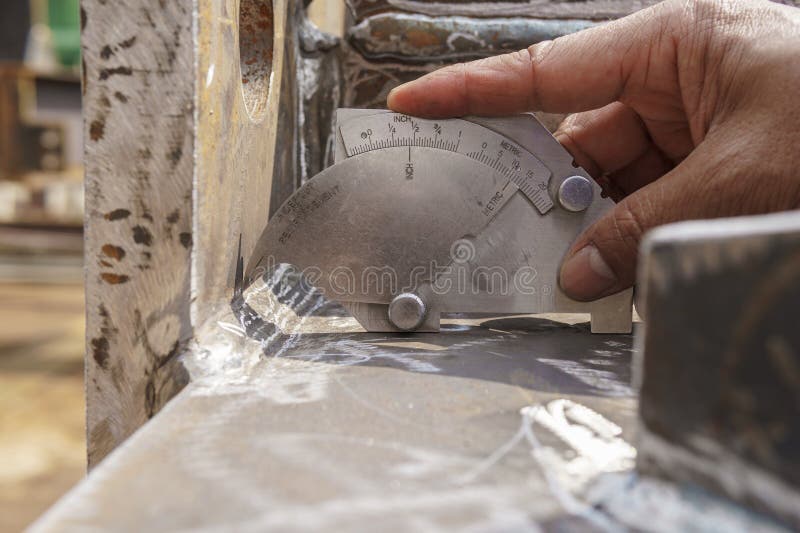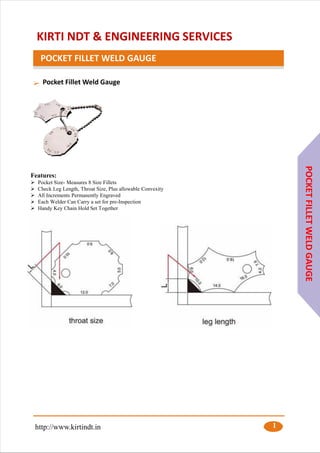Ingenious Methods to Fillet Weld Inspection and Testing: Enhancing Weld Top Quality and Compliance Criteria
In the realm of welding, the high quality and stability of fillet welds play a crucial role in ensuring the architectural soundness and reliability of various commercial elements. With the consistent drive for improved performance and compliance with rigorous requirements, the expedition of cutting-edge strategies to fillet weld inspection and screening has actually become critical.
Advanced Non-Destructive Testing Techniques
Making use of cutting edge technologies, advanced non-destructive screening techniques play a vital duty in making sure the stability and high quality of fillet welds. These methods, such as phased array ultrasonic screening (PAUT) and magnetic bit screening (MPT), deal detailed insights into the weld's inner framework without triggering any kind of damage to the material. PAUT, for example, makes use of numerous ultrasonic elements to evaluate the weld from different angles, providing an extensive visualization of potential flaws like lack of combination or cracks.
By using these advanced non-destructive screening strategies, weld examiners can precisely examine the quality of fillet welds, making sure conformity with sector requirements and guidelines. The ability to discover flaws early on not just improves weld quality yet additionally stops expensive rework or failures in architectural integrity, highlighting the significance of these cutting-edge testing approaches in welding evaluations.
Robotics and Automation in Inspection

The assimilation of robotics and automation has transformed the inspection process for fillet welds, improving efficiency and precision in high quality assessment. Robotics use accurate control and repeatability in inspecting welds, making certain reliable and regular results. Automated systems can be set to follow details evaluation paths, making sure comprehensive insurance coverage of welds and minimizing the threat of human error.
Robotic assessment systems equipped with advanced sensors can find and determine weld attributes with high accuracy, providing comprehensive information for evaluation. These systems can determine flaws such as cracks, lack of combination, and porosity, making it possible for punctual corrective actions to be taken. Furthermore, robotics and automation permit real-time information collection and evaluation, giving prompt feedback to operators and helping with fast decision-making processes.
Additionally, making use of robotics and automation in fillet weld assessment boosts total performance by decreasing evaluation times and enhancing assessment throughput. By enhancing the examination procedure, suppliers can make certain weld top quality and conformity criteria are satisfied effectively, eventually resulting in cost savings and boosted item high quality.
Using Expert System for Analysis
Artificial knowledge plays an essential function in improving the performance and accuracy of evaluation in fillet weld assessment procedures. By taking advantage of the power of AI, assessors can simplify the analysis of weld high quality and compliance standards, bring about a lot more trustworthy and precise outcomes. AI algorithms can swiftly refine large amounts of information from weld examinations, spotting flaws or incongruities that may be challenging to understand the naked eye. This innovative innovation allows real-time tracking of weld top quality, enabling immediate restorative activities to be taken if any type of issues are identified.
In addition, AI systems can learn from previous inspection data, consistently improving their capability to recognize potential problems and inconsistencies in fillet welds. This adaptive knowing capacity improves the total quality assurance process, minimizing the likelihood of human error and making sure that welds fulfill the required standards. By integrating expert system right into fillet weld evaluation, markets can attain greater degrees of performance, uniformity, and conformity in their website their inspection practices.
Portable Tools for On-Site Evaluation
Enhancing field assessment effectiveness, the fostering of mobile tools reinvents on-site evaluation procedures for fillet welds. These tools provide versatility and comfort, enabling examiners to conduct thorough evaluations in different locations, including challenging or remote environments. Mobile tools such as ultrasonic screening gadgets, magnetic particle evaluation devices, and electronic radiography systems supply real-time information and high-resolution imaging capacities, enabling fast decision-making and prompt responses on weld quality.
One substantial benefit of mobile tools is their ability to improve inspection procedures, reducing downtime and boosting general performance - Gauge Fillet Weld. Assessors can conveniently transport these devices to various job websites, getting rid of the requirement for transferring hefty equipment or components to off-site centers. Furthermore, the portability of these tools advertises cost-effectiveness by reducing transportation expenditures and accelerating examination timelines
Additionally, the usage of portable tools for on-site evaluation promotes proactive quality assurance procedures, as examiners can quickly recognize and attend to any possible welding defects or disparities. By incorporating these cutting-edge technologies right into on-site assessment methods, welding specialists her response can guarantee conformity with industry requirements and enhance weld high quality, inevitably resulting in boosted structural stability and safety and security in various welding applications.
Combination of Information Management Solution

Having actually maximized on-site examination procedures through the utilization of mobile tools, the next stage includes the seamless assimilation of data management systems to better improve efficiency and information analysis capacities in fillet weld assessment and testing. By incorporating data monitoring systems into the inspection process, organizations can improve data collection, storage space, and evaluation. This integration permits for real-time tracking of weld quality, instant recognition of flaws, and prompt decision-making to remedy any concerns that may develop during the examination process.
Information management systems play a critical function in systematizing evaluation information, facilitating simple access for licensed employees, and ensuring data honesty and security. With the assimilation of these systems, inspectors can produce detailed records, track historical information for fad analysis, and enhance total procedure efficiency. The assimilation of information monitoring systems enables seamless interaction in between various stakeholders entailed in the inspection process, promoting partnership and improving general high quality control procedures. Eventually, the combination of data administration systems serves to raise the standards of fillet weld evaluation and testing, guaranteeing compliance with sector laws and boosting weld top quality.
Conclusion
Finally, ingenious strategies to fillet weld assessment and testing have actually considerably enhanced weld top quality and conformity standards. Advanced non-destructive screening approaches, robotics, automation, man-made knowledge, portable devices, and data monitoring systems have revolutionized the method weld inspections are performed. By using these modern technologies, markets can make certain that welds meet the required quality standards and policies, ultimately boosting overall effectiveness and safety in welding processes.

Having optimized on-site examination processes through the application of mobile devices, the next phase involves the seamless assimilation of data administration systems to better improve performance and information analysis abilities in fillet weld evaluation and screening. Eventually, the integration of information management systems offers to elevate the requirements of fillet weld inspection and screening, guaranteeing conformity with market regulations and enhancing weld quality.
